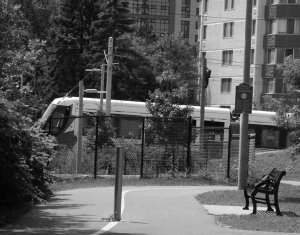By John Dance
In July, after a 40-minute “settlement hearing,” the Ontario Land Tribunal (formerly the Local Planning Appeal Tribunal) took the final step to reverse a misguided City of Ottawa attempt to remove the Lees Avenue campus of the University of Ottawa from Old Ottawa East and Capital Ward.
It took eight months of a community effort to undo a poorly conceived and consulted-upon measure that was ostensibly to improve the boundaries of Capital and Rideau-Vanier wards.
Only after the City’s Finance and Economic Development Committee had approved the change last December did the OOE Community Association (OOECA) become aware of the measure. City Council approved the new ward boundaries a week later so that OOECA’s only recourse was to make an appeal to LPAT.

The pathway behind uOttawa’s Lees Avenue campus and the rest of the campus will remain a part of Old Ottawa East as a result of a recent decision of the Ontario Land Tribunal. Photo by John Dance
At no point was the Old Ottawa East community ever asked if the transfer was a sound idea, one that would meet the criteria set by the Supreme Court to ensure “effective representation” through the setting of electoral boundaries. Key criteria include balancing voter parity, good physical boundaries and respect for “communities of interest.”
The City argued that the ward boundary wouldn’t affect voter parity because nobody lived on the Lees campus. They said the change would support the “community of interest” made up of users of Rideau-Vanier’s Robinson Field and that the Rideau River, rather than Highway 417, would become the new and better boundary between the two wards.
In its appeal, OOECA countered that there is considerable potential for residents on the campus given zoning that allows buildings of up to 45 storeys. Also, it noted that Old Ottawa East constitutes a far more important “community of interest” in the Lees campus than do itinerant users of sports fields. In addition, OOECA ridiculed the City’s proposition that the river would be the new boundary (the below-grade LRT line would have been) and that the new boundary would be a better boundary than Highway 417.
The City did not want major changes to ward boundaries – like the consolidation of rural wards and the addition of two suburban wards – delayed because of OOECA’s appeal and a similar one launched by the Overbrook Community Association. As a result, City staff recommended to City Council that it reverse its December decision and Council agreed to this in April. But then LPAT had to agree to the reversal.
If this all sounds a little tedious, unnecessary and costly that’s because it was. Although OOECA spent just $400 to file the appeal, the City budgeted $15,000 to $75,000 for appeals. For the actual LPAT hearing, the City produced two lengthy affidavits, one 135 pages long and the other 16 pages.
“We’re very glad that a resolution has been achieved that keeps all of Old Ottawa East in Capital Ward,” commented Capital Ward Councillor Shawn Menard. “It was never ideal to split a community between wards. I’d like to thank all the residents and the community association who worked so hard on this.”
At the LPAT hearing, despite speaking in favour of the reversal of the original council decision, City solicitor Tim Marc still spoke of how the river would have been the new and better boundary and he still argued that there were no voter parity issues. He did, however, concede that OOE does constitute a more important community of interest than itinerant sports field users.
We knew that. The question is “Why didn’t the City recognize this last year and not propose the removal of the Lees campus from Old Ottawa East and Capital Ward?” The answer may never be known given the lack of transparency the City administration continues to exhibit.






